|
|
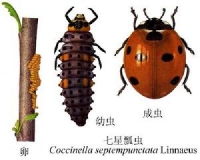 瓢虫 瓢虫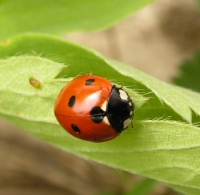 瓢虫 瓢虫 |
|
| 昆虫名。成虫半球形,头小。种类很多,颜色不一。前翅坚硬,上有黑色或黄色斑点,也有无斑点的。幼虫体略长,尾端细小。多数种类捕食蚜虫、螨类等,对农业、林业有益。 |
|
身体像半个圆球、生有漂亮色斑的昆虫。种类很多,有吃植物的有害瓢虫,如马铃薯虫;也有捕食小虫的有益瓢虫,如能捕食柑橘的主要害虫的大红瓢虫。瓢虫的头很小,头的一部分常常隐藏在前胸背板下面。生有一对较大的复眼和一对像小棍一样的触角。现在人们常用瓢虫来防治为害农作物的蚜虫。七星瓢虫、小红瓢虫和异色瓢虫都是捕食蚜虫和介壳虫的益虫。
瓢虫或许是花园中最负盛名,也是最受喜爱的居民,因为它们乖巧迷人,色彩斑澜,但它们同样也是食肉动物,而且是较为贪婪的捕食者。 |
|
成年瓢虫会捕食任何肉质嫩软的昆虫,它们最喜欢吃的是蚜虫,但只要是没有披戴盔甲和其他保护外套,而且身体柔软、体型小的昆虫,都有可能成为他们的美餐。
猎物们不会自投罗网,瓢虫必须经常飞动去搜索目标。瓢虫看上去不大可能会飞,它的体型不象个飞行员,而更象是个药箱。它有一个坚硬的外套,而它那套细小精致的翅膀会从外套下伸出,疯狂地舞动。瓢虫确实是一个技艺精湛的飞行家,也正是因为它们具有高超的飞行本领,所以才能在花园的各个角落里来去自如。
雌瓢虫会产下大量的卵,它通常把卵分布在蚜虫时常出没的地方,以确保自己的儿女出生后能获取最大的生存机率。卵被孵化后,新出生的幼虫就会把身边的蚜虫做为它们可口的小吃,幼虫的模样与它的父母区别很大,它们还没有装备上厚实的盔甲,身体非常柔软,成节状分布,但却长着些坚硬的鬃毛,可以起到保护作用。它们的下颚强壮有力,形状就象一把钳子,能够轻易地洞穿蚜虫的身体。 |
|
幼虫的生活单调乏味,它们每天游弋在花草之间,疯狂地捕食蚜虫,比成年瓢虫吃得还多。瓢虫的生命非常短暂,从卵生长到成虫时期只需要大约一个月的时间,所以无论什么时候,我们都可以在花园里同时发现瓢虫的卵、幼虫和成虫。
随着时间的推移,瓢虫的幼虫胃口越来越大,身体也在不断地增长,他们必须挣脱旧皮肤的束缚,开始了一个艰辛的历程——蜕皮。这个过程并不象我们脱掉旧衣服,再换一件大号外套那么简单。瓢虫一生之中,要经历5至6次蜕皮,每次蜕皮后,身体都会继续增长,直到积蓄足够的能量步入虫蛹阶段。
当瓢虫准备化蛹时,它会先找一个安全的地方,把自己悬挂着附在叶面下,然后开始经历惊心动魄的转变。
它会从一个身体娇柔的幼虫变成体质强壮的成年瓢虫。这是一个令人难以想象的过程,幼虫的身体将被分解,然后重新组合、调整,再加以修饰装扮,这一切都是为了迎接它崭新的生命。当它最后破蛹而出变为一只新的成年瓢虫时,还要经历一些转变,因为此时它的身体仍旧柔软娇嫩,尚未完全发育成熟,它必须暴露在阳光下,吸取氧份,使它的体色慢慢加深,斑纹也会逐渐显露出来,几个小时后,它就会变得和花园中其他成年瓢虫一模一样了。 |
瓢虫的居住 Ladybug's residence |
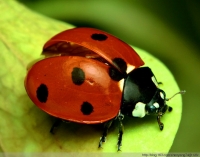 瓢虫的居住 瓢虫的居住
对于昆虫来说,一粒雨滴有多种含义。如果他们想饮水,那么雨滴就相当于水池,一个看不见底的巨大水杯。当然对于蚜虫来说,雨滴更显得其大无比。而水滴表面的张力也可以使小昆虫象陷入沼泽地一样无法自拔。 |
|
瓢虫的生命一般非常短暂,只有一个月左右的时间。但在夏季末期出生的最后一代瓢虫却拥有较长的寿命,当他们长到成年的时候,他们会寻找一个隐蔽安全的地方,隐居起来,准备度过漫长的冬天。
当寒冷的季节来临,瓢虫们将会依靠集体的力量抵抗严寒。他们在树桩或岩石下一些干燥安全的地方聚集起来,一同渡过漫漫的严冬。
瓢虫科(coccinellidae;lady beetles) |
|
昆虫纲,鞘翅目的1科,也称瓢甲科。
中、小型;体背面圆隆,腹面平坦;跗节为隐四节类;常具鲜明色斑的甲虫。本科昆虫通称瓢虫。在植物上捕食蚜虫、 介壳虫、粉虱、叶螨等。虽有少数瓢虫为害栽培作物,但大多数种类为农作物害虫的天敌。
瓢虫科与鞘翅目其他各科的主要不同点是:
①典型的跗节为隐四节类,第2节宽大,第3节特别细小,第4节特别细长,第3、4节连成一体,细长,称附爪端节,自第2节的凹陷或分裂中伸出;一些种类第3节退化或与第4节愈合,因而附爪端节仅有1节;但在 4节瓢虫亚科中,附节的第2节不特别宽大,第3节不特别细小,第4节不特别细长,构成4节式;
②可见的第1腹板在基节窝之后有后基线,仅少数属不具此特征;
③下鄂须末节斧状,两侧向末端扩大,或两侧相互平行;如果两侧向末端收窄,则至少前端减薄而且平截;但小艳瓢虫亚科的下颚须末节锥形、长锥形、卵形或圆筒形而向末端缩小。
大多数瓢虫同时具有上述3个特征。仅有少数类群只具备其中的两个特征。 |
瓢虫的种类 The type of ladybug |
瓢虫的种类非常繁多,任何时候我们都能在花园里发现不同种类的瓢虫。我们可以从它们的颜色上加以区别,有些是黄色,有些是桔色或红色,我们也可以根据它们的体型来区别,有些体型瘦小,有些则较为粗壮。但识别它们的最好途径是通过它们身上的斑点,有些瓢虫有两个斑点,有些有9个,有些有12个,有些则一个也没有。
全世界记载约500属5000种。中国已记录近400种。其中,植食性的种约占1/6。食植瓢虫亚科的大多数种类取食茄科、葫芦科、菊科植物,也有的取食豆科、禾本科、 葡萄科、 八仙花科、毛茛科、荨麻科、五味子科、马鞭草科、茜草科等植物,少数种类取食蕨类(海金砂科)。其中一些种以栽培作物为食,例如分布于古北界的马铃薯瓢虫和分布于印度-马来亚区的茄二十八星瓢虫为害马铃薯和茄子;分布于印度-马来亚区的瓜裂臀瓢虫为害瓜类;分布于印度-马来亚区的大豆瓢虫和分布于北美的墨西哥豆瓢虫为害大豆。这些都是重要的栽培作物害虫。在瓢虫亚科中的食菌瓢虫族以真菌(白粉病菌的菌丝和孢子)为食。
除此以外,瓢虫亚科的大部分和刻眼瓢虫亚科主要以蚜虫为食,小毛瓢虫亚科和小艳瓢虫亚科捕食蚜虫、介壳虫、粉虱、叶螨;其中食螨瓢虫族专食叶螨,是叶螨的重要天敌;隐胫瓢虫亚科捕食蚜虫和介壳虫;盔唇瓢虫亚科捕食有蜡质覆盖物的介壳虫(如盾蚧、蜡蚧等),其唇基向两侧和向前伸展,成为掀开蜡质介壳的特殊构造;四节瓢虫亚科和红瓢虫亚科取食绵蚜和绵蚧,其幼虫背面亦覆盖蜡粉或蜡质丝,外形与取食对象相似(拟态)。在捕食性的瓢虫中,七星瓢虫是古北界常见的蚜虫天敌,中国采取助迁和保护的方法用它来防治棉蚜。
近10年来,美国东北部也出现了七星瓢虫,其分布区在不断扩展。异色瓢虫也是古北界常见的蚜虫天敌,因其色斑变异很大,曾用于遗传学的研究。澳洲瓢虫于1888年从大洋洲引入美国,以防治当时严重为害柑橘的吹绵蚧。散放后的第二年,吹绵蚧的种群数量明显下降。随后,又引入到其他热带和亚热带地区,也都取得长期控制吹绵蚧的良好效果,成为引进天敌的第一个著名成功范例。小红瓢虫原产于亚洲南部,1928年自日本引入塞舌尔共和国、加罗林群岛、马里亚纳群岛、马绍尔群岛以防治塞舌尔吹绵蚧。这也是引进天敌防治害虫的成功范例之一。中国曾把大红瓢虫移殖到湖北省宜都县,以防治柑橘园内的吹绵蚧,同样取得良好的效果。
此外,还有二星瓢虫、四星瓢虫、六星瓢虫、双七瓢虫、九星瓢虫、十星瓢虫、十一星瓢虫、十二星瓢虫、十三星瓢虫、十四星瓢虫、二十八星瓢虫、刀角瓢虫、大红瓢虫、红环瓢虫、纵条瓢虫、六斑显盾瓢虫、艳色广盾瓢虫等等
中文名: 七星瓢虫
拉丁学名: coccinella septempunctata linnaeus
纲: 昆虫纲
目: 鞘翅目
科: 瓢虫科瓢虫亚科
功能类别: 捕食性天敌
寄主昆虫: 棉蚜、麦蚜、豆蚜、菜缢管蚜、玉米蚜、高粱蚜
寄主危害作物: 棉花、小麦、豇豆、白菜、玉米、高粱 |
|
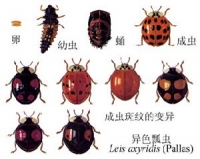 瓢虫 形态特征 瓢虫 形态特征
雄虫:第六腹节后缘平截,中部有横凹陷坑,上缘有一排长毛。
卵:长1.26毫米;宽0.60毫米。橙黄包,长卵形,两端较尖。成堆竖立在棉叶背面。每块卵一般20一40粒,最多达80粒。
幼虫:共4龄.各龄期的主要特征:
一龄:体长2—3毫米。身体全黑色。从中胸至第八腹节,每节各有6个毛疣。
二龄:体长4毫米。头部和足全黑色,体灰黑色。前胸左右后侧角黄色。腹部每节背面和侧面着生6个刺疣,第一腹节背面左右2刺疣呈黄色,刺黑色。第四腹节背面刺疣黄色斑不显.其余刺疣黑色。
三龄:体长7毫米。体灰黑色.头、足、胸部背板及腹末臀板黑色。前胸背板前侧角和后侧角有黄色斑。腹部第一节左右侧刺疣和侧下刺疣桔黄色,刺黑包。第四节背侧2刺疣微带黄色,其余刺疣黑色。
四龄:体长11毫米左右。体灰黑色。前胸背板前侧角和后侧角有桔黄色斑。腹部第一节和第四节左右侧刺疣和侧下刺疣均有桔黄色斑。其余刺疣黑色。
蛹:体长7毫米,宽5毫米。体黄色。前胸背板前缘有4个黑点,中央2个呈三角形,前胸背板后缘中央有2个黑点,两侧角有2个黑斑。中胸背板有2个黑斑。腹部第2—6节背面左右有4个黑斑。腹末带有末龄幼虫的黑色蜕皮。 |
七星瓢虫简介 About Coccinella septempunctata |
俗称花大姐。
分布在我国东北、华北、华中、西北、华东和西南等一些省区;另记载于蒙古、朝鲜、日本、原苏联、印度及欧洲地区。
成虫体长5.2-6.5毫米,宽4-5.6毫米。身体卵圆形,背部拱起,呈半个水瓢状。头黑色、复眼黑色,内侧凹入处各有1淡黄色点。触角褐色。口器黑色。上额外侧为黄色。前胸背板黑,前上角各有1个较大的近方形的淡黄地。小盾片黑色。鞘翅红色或橙黄色,两侧共有7个黑斑;翅基部在小盾片两侧各有1个三角形白地。体腹及足黑色。
年发生多代。以成虫过冬,次年4月出蛰。产卵于有蚜虫的植物寄主上。成虫和幼虫均以多种蚜虫、木虱等为食。系益虫,应予保护。
七星瓢虫是著名的害虫天敌,成虫可捕食麦蚜、棉蚜、槐蚜、桃蚜、介壳虫、壁虱等害虫,可大大减轻树木、瓜果及各种农作物遭受害虫的损害,被人们称为“活农药”。
七星瓢虫是鞘翅目瓢虫科的捕食性天敌昆虫,在我国各地广泛分布。20世纪70年代在黄河下游已开始用助迁法防治棉花和小麦蚜虫,90年代开始人工繁殖,并用于生产。 七星瓢虫以鞘翅上有7个黑色斑点而得名。每年发生世代数因地区不同而异。例如,在河南安阳地区每年发生6-8代。北方寒冷地区,每年发生世代数则较少。七星瓢虫成虫寿命长,平均77天,以成虫和幼虫捕食蚜虫、叶螨、白粉虱、玉米螟、棉铃虫等幼虫和卵。七星瓢虫1头雌虫可产卵567-4475粒,平均每天产卵78.4粒,最多可达197粒。 七星瓢虫取食量大小与气温和猎物密度有关。以捕食蚜虫为例,在猎物密度较低时,捕食量随密度上升而呈指数增长;在密度较高时,捕食量则接近极限水平。气温高的条件下,影响七星瓢虫和猎物的活动能力,捕食率提高。据统计,七星瓢虫对烟蚜的平均日取食量为:1龄10.7头,2龄33.7头,3龄60.5头,4龄124.5头,成虫130.8头。七星瓢虫近80天的生命期可取食上万头蚜虫。 毒性 七星瓢虫对人、畜和天敌动物无毒无害,无残留,不污染环境。
七星瓢虫在我国分布相当广泛,分布的地区有北京、辽宁、吉林、黑龙江、河北、山东、山西、河南、陕西、江苏、浙江、上海、湖北、湖南、江西、福建、广东、四川、云南、新疆、西藏、内蒙古等地,常见于农田、森林、园林、果园等处。
七星瓢虫是著名的害虫天敌,成虫可捕食麦蚜、棉蚜、槐蚜、桃蚜、介壳虫、壁虱等害虫,可大大减轻树木、瓜果及各种农作物遭受害虫的损害,被人们称为“活农药”。
七星瓢虫有较强的自卫能力,虽然身体只有黄豆那么大,但许多强敌都对它无可奈何。它3对细脚的关节上有一种“化学武器”,当遇到敌害侵袭时,它的脚关节能分泌出一种极难闻的黄色液体,使敌人因受不了 而仓皇退却、逃走。它还有一套装死的本领,当遇到强敌和危险时,它就立即从树上落到地下,把3对细脚收缩在肚子底下,装死躺下,瞒过敌人而求生。
瓢虫之间还有一种奇妙的习性:益虫和害虫之间界限分明,互不干扰,互不通婚,各自保持着传统习惯,因而不论传下多少代,不会产生“混血儿”,也不会改变各自的传统习性。 |
|
 瓢虫 基本资料 瓢虫 基本资料
中文名称:瓢虫
拉丁学名:Coccinellidae
英文名称:ladybird(又称ladybug)
别名:红娘、金龟、金龟子、臭龟子、花大姐
科学分类
动物界 Animalia
节肢动物门 Arthropoda
昆虫纲 Insecta
内翅总目 Endopterygota
鞘翅目 Coleoptera
多食亚目 Polyphaga
扁甲总科 Cucujoidea
瓢甲科 Coccinellidae Latreille, 1807
简介
瓢虫为鞘翅目瓢虫科圆形突起的甲虫的通称,是体色鲜艳的小型昆虫,常具红、黑或黄色斑点。英文名ladybirds里的“lady”一般被认为是暗指在天主教信仰中的圣母玛利亚。全世界有超过5,000种以上的瓢虫,其中450种以上栖息于北美洲。
身体像半个圆球、生有漂亮色斑的昆虫。有吃植物的有害瓢虫,如马铃薯虫;也有捕食小虫的有益瓢虫,如能捕食柑橘的主要害虫的大红瓢虫。瓢虫的头很小,头的一部分常常隐藏在前胸背板下面。生有一对较大的复眼和一对像小棍一样的触角。现在人们常用瓢虫来防治为害农作物的蚜虫。七星瓢虫、小红瓢虫和异色瓢虫都是捕食蚜虫和介壳虫的益虫。
瓢虫科与鞘翅目其他各科的主要不同点
①典型的跗节为隐四节类,第2节宽大,第3节特别细小,第4节特别细长,第3、4节连成一体,细长,称附爪端节,自第2节的凹陷或分裂中伸出;一些种类第3节退化或与第4节愈合,因而附爪端节仅有1节;但在 4节瓢虫亚科中,附节的第2节不特别宽大,第3节不特别细小,第4节不特别细长,构成4节式;
②可见的第1腹板在基节窝之后有后基线,仅少数属不具此特征;
③下鄂须末节斧状,两侧向末端扩大,或两侧相互平行;如果两侧向末端收窄,则至少前端减薄而且平截;但小艳瓢虫亚科的下颚须末节锥形、长锥形、卵形或圆筒形而向末端缩小。
大多数瓢虫同时具有上述3个特征。仅有少数类群只具备其中的两个特征。 |
|
| 形似半个圆球,一般5∼10毫米(0.3∼0.4吋)长。足短,色鲜艳,具黑、黄或红色斑点。鞘翅颜色和斑点数因种类而异,九星瓢虫(Coccinellanovemnotata)的图案是在橘红鞘翅上各有4个黑斑点,以及各有半个斑点,这是典型的瓢虫颜色图案。 |
|
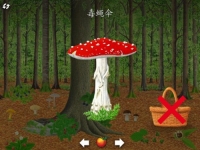 瓢虫 生活习性 瓢虫 生活习性
七星瓢虫(Coccinella 7-punctata)的幼虫幼虫的生活单调乏味,它们每天游弋在花草之间,疯狂地捕食蚜虫。瓢虫的生命非常短暂,从卵生长到成虫时期只需要大约一个月的时间,所以无论什么时候,我们都可以在花园里同时发现瓢虫的卵、幼虫和成虫。
随着时间的推移,瓢虫的幼虫胃口越来越大,身体也在不断地增长,他们必须挣脱旧皮肤的束缚,开始了一个艰辛的历程——蜕皮。这个过程并不象我们脱掉旧衣服,再换一件大号外套那么简单。瓢虫一生之中,要经历5至6次蜕皮,每次蜕皮后,身体都会继续增长,直到积蓄足够的能量步入虫蛹阶段。
当瓢虫准备化蛹时,它会先找一个安全的地方,把自己悬挂着附在叶面下,然后开始经历惊心动魄的转变。
它会从一个身体娇柔的幼虫变成体质强壮的成年瓢虫。这是一个令人难以想象的过程,幼虫的身体将被分解,然后重新组合、调整,再加以修饰装扮,这一切都是为了迎接它崭新的生命。当它最后破蛹而出变为一只新的成年瓢虫时,还要经历一些转变,因为此时它的身体仍旧柔软娇嫩,尚未完全发育成熟,它必须暴露在阳光下,吸取氧份,使它的体色慢慢加深,斑纹也会逐渐显露出来,几个小时后,它就会变得和花园中其他成年瓢虫一模一样了。
成虫的捕猎
七星瓢虫(Coccinella 7-punctata)的成虫成年瓢虫会捕食任何肉质嫩软的昆虫,它们最喜欢吃的是蚜虫,但只要是没有披戴盔甲和其他保护外套,而且身体柔软、体型小的昆虫,都有可能成为他们的美餐。
猎物们不会自投罗网,瓢虫必须经常飞动去搜索目标。瓢虫看上去不大可能会飞,它的体型不像个飞行员,而更像是个药箱。它有一个坚硬的外套,而它那套细小精致的翅膀会从外套下伸出,疯狂地舞动。瓢虫确实是一个技艺精湛的飞行家,也正是因为它们具有高超的飞行本领,所以才能在花园的各个角落里来去自如。
雌瓢虫会产下大量的卵,它通常把卵分布在蚜虫时常出没的地方,以确保自己的儿女出生后能获取最大的生存机率。卵被孵化后,新出生的幼虫就会把身边的蚜虫做为它们可口的小吃,幼虫的模样与它的父母区别很大,它们还没有装备上厚实的盔甲,身体非常柔软,成节状分布,但却长着些坚硬的鬃毛,可以起到保护作用。它们的下颚强壮有力,形状就象一把钳子,能够轻易地洞穿蚜虫的身体。
成虫、幼虫在受到刺激时,都会分泌一种淡黄色液体(成分为生物碱),虽然无毒,但具有强烈的刺激性气味,借以驱散敌害。 |
生长繁殖 Growth and reproduction |
瓢虫为甲虫类生物,会经历卵 - 幼虫 - 蛹 - 成虫四阶段的完全变态。
瓢虫的生活周期约需4周,故每年夏季可繁殖数代。幼虫细长柔软,通常灰色,具蓝、绿、红或黑色斑,以其他昆虫或虫卵为食。要经4个龄期,然后附于某些物体上,在最后一龄幼虫所蜕的皮中化蛹。大群的瓢虫常在同一处地点过冬。 |
瓢虫种类 Species of ladybirds |
 瓢虫种类 瓢虫种类
全世界记载约500属5000种。中国已记录近400种。其中,植食性的种约占1/6。食植瓢虫亚科的大多数种类取食茄科、葫芦科、菊科植物,也有的取食豆科、禾本科、 葡萄科、 八仙花科、毛茛科、荨麻科、五味子科、马鞭草科、茜草科等植物,少数种类取食蕨类(海金砂科)。其中一些种以栽培作物为食,例如分布于古北界的马铃薯瓢虫和分布于印度-马来亚区的茄二十八星瓢虫为害马铃薯和茄子;分布于印度-马来亚区的瓜裂臀瓢虫为害瓜类;分布于印度-马来亚区的大豆瓢虫和分布于北美的墨西哥豆瓢虫为害大豆。这些都是重要的栽培作物害虫。在瓢虫亚科中的食菌瓢虫族以真菌(白粉病菌的菌丝和孢子)为食。
除此以外,瓢虫亚科的大部分和刻眼瓢虫亚科主要以蚜虫为食,小毛瓢虫亚科和小艳瓢虫亚科捕食蚜虫、介壳虫、粉虱、叶螨;其中食螨瓢虫族专食叶螨,是叶螨的重要天敌;隐胫瓢虫亚科捕食蚜虫和介壳虫;盔唇瓢虫亚科捕食有蜡质覆盖物的介壳虫(如盾蚧、蜡蚧等),其唇基向两侧和向前伸展,成为掀开蜡质介壳的特殊构造;四节瓢虫亚科和红瓢虫亚科取食绵蚜和绵蚧,其幼虫背面亦覆盖蜡粉或蜡质丝,外形与取食对象相似(拟态)。在捕食性的瓢虫中,七星瓢虫是古北界常见的蚜虫天敌,中国采取助迁和保护的方法用它来防治棉蚜。
近10年来,美国东北部也出现了七星瓢虫,其分布区在不断扩展。异色瓢虫也是古北界常见的蚜虫天敌,因其色斑变异很大,曾用于遗传学的研究。澳洲瓢虫于1888年从大洋洲引入美国,以防治当时严重为害柑橘的吹绵蚧。散放后的第二年,吹绵蚧的种群数量明显下降。随后,又引入到其他热带和亚热带地区,也都取得长期控制吹绵蚧的良好效果,成为引进天敌的第一个著名成功范例。小红瓢虫原产于亚洲南部,1928年自日本引入塞舌尔共和国、加罗林群岛、马里亚纳群岛、马绍尔群岛以防治塞舌尔吹绵蚧。这也是引进天敌防治害虫的成功范例之一。中国曾把大红瓢虫移殖到湖北省宜都县,以防治柑橘园内的吹绵蚧,同样取得良好的效果。
此外,还有二星瓢虫、四星瓢虫、六星瓢虫、双七瓢虫、九星瓢虫、十星瓢虫、十一星瓢虫、十二星瓢虫、十三星瓢虫、十四星瓢虫、二十八星瓢虫、刀角瓢虫、大红瓢虫、红环瓢虫、纵条瓢虫、六斑显盾瓢虫、艳色广盾瓢虫等等。 |
|
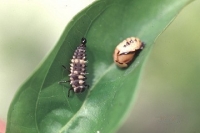 瓢虫 生物作用 瓢虫 生物作用
有个耳熟能详的童谣:“瓢虫快快飞,赶紧往家走,你家着了火,孩子满处游”(Ladybugladybug,flyawayhome/Yourhouseisonfire,yourchildrendoroam),说的是英国于收割后焚烧忽布藤,这不但清了地,还烧死了许多瓢虫。瓢虫在民间药方中用以治疗绞痛、麻疹和牙痛。 |
|
- : n small flying beetle, reddish-brown or yellow with black spots
- n.: ladybird, ladybug
|
|
- n. coccinelle
|
|
|